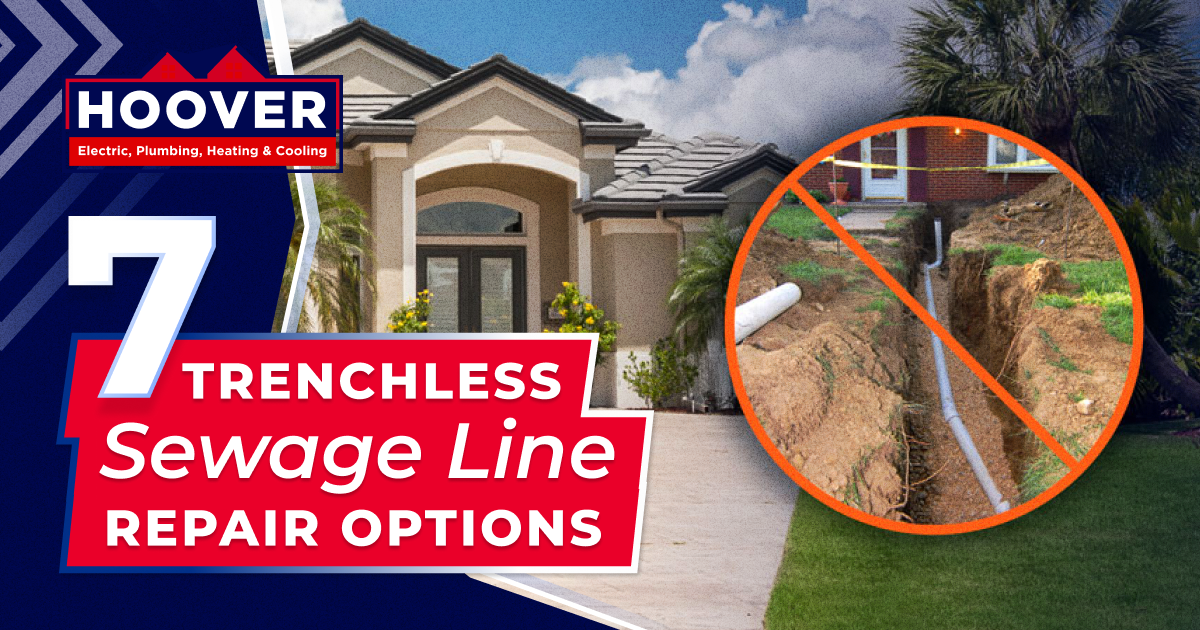
Experienced plumbers know several types of sewer line repair. The traditional way to fix or replace sewer lines is to dig them up. However, newer technologies have refined the process, so it’s often less invasive. Our plumbing technicians will explain the options based on the nature, size, and location of the problem. If you need sewage line repair in Troy, MI, we’ll cover some effective ways a contractor can proceed.
Digging massive ditches across your yard or landscape to access, inspect, and repair or replace sewer pipes is no longer the only option. Alternatives to this invasive process include:
1. Sewer Pipe Clamps
If a leak is caused by a small crack, an industrial-grade, corrosion-resistant clamp can be used to seal it. Just a small hole is dug to reach the leak site. The plumber then tightens the clamp around the damaged pipe section and refills the hole. A cost-effective solution, clamping can last for the life of the sewer line.
2. Cured-In-Place Pipe
Another trenchless repair method is a cured-in-place pipe (CIPP). This repair method requires no digging; instead, a textile liner made of epoxy resin is inserted at a manhole or excavation point. The polyester or fiberglass liner is inserted or pulled into the damaged pipe, using water or air pressure, and allowed to cure in place, forming a pipe within a pipe. Any cracks or holes are permanently sealed.
3. Pull-In Place Lining
Two access points are needed to place a lining material molded to the shape of the pipe. The epoxy-saturated liner is inserted at one end and pulled through the pipe from the other end. When it’s in place, the technician sends air through the line to expand the liner inside the sewer pipe. Hot steam is sent through to adhere the liner to the interior surface to complete the sewage line repair.
4. Pipe Bursting
Extensively damaged sewer pipes can’t be fixed with the above techniques. But pipe bursting can fix a severely damaged line without digging it up. After digging two access pits, the repair crew will insert a hydraulically-powered bursting head into the sewer pipe. This powerful machine breaks the old pipe apart and pushes the fragments aside. At the same time, it pulls a new section of pipe into place.
5. Directional Drilling
Not all trenchless sewage line repair methods completely avoid digging. Directional drilling involves creating a tunnel for a new sewer line. A horizontal drilling machine bores into the ground; it then drills below the surface, several feet under the existing pipe, to create space for a new pipe to be inserted. The system also removes dirt and debris from the tunnel and the old piping can be left as is or removed and discarded.
6. Sliplining
Sliplining is an older method of trenchless pipe repair. A lead-in trench is dug to insert and then pull or push new pipe sections (“carrier” pipes) into an existing line. The new pipe is smaller than the old one and fits completely inside the old line (grout fills the void between them). Flexible or rigid gasketing joints can be welded into place to join short pipe sections. The carrier pipe is typically high-density polyethylene, polyvinyl chloride, or fiberglass-reinforced.
7. Internal Pipe Coating
Manual coating methods may be used for larger pipes accessible via a manhole. Once the sewage line is drained, the contractor goes in and pressure washes the pipe to remove foreign debris and materials; the pipe is then allowed to dry. Next, they spray the coating onto the interior surface. The spray consists of a thick epoxy coating that seals leaks and cracks. It can also prevent new leaks from forming.
How to Choose a Sewage Line Repair Method
All of these methods effectively seal sewer pipe leaks. However, the best one depends on:
- The Level of Damage: Clamping, sliplining, and internal pipe coating methods are effective if the damage is limited. For more extensive leaks, cured-in-place and pull-in place linings are typically used, while pipe bursting is a long-term solution to replace a damaged section of sewer pipe.
- Repair Options: Not every sewer repair contractor specializes in every method of trenchless sewage line repair. And, there may be a limited number of contractors of this trade in your area. Therefore, you may be limited to what they can provide.
- Your Budget: Every sewer line repair method comes at a different price point. Determine what options are available and suited for your needs and request a cost estimate for each. This way, you can compare these options and choose the most affordable one.
Schedule Sewage Line Repair in Troy, MI
Hoover Electric, Plumbing, Heating & Cooling specializes in sewage line repair. Our licensed technicians can fix any issue (regardless of its size, scope, or location) and can provide a wide range of repair options. Whether a sewer line is cracked, broken, collapsed, corroded, shifted, or blocked by tree roots, we can find a solution. We use the most advanced inspection cameras, pipe lining methods, and cutting equipment.
To request help, contact us on the web or call (586) 500-5163 today.


